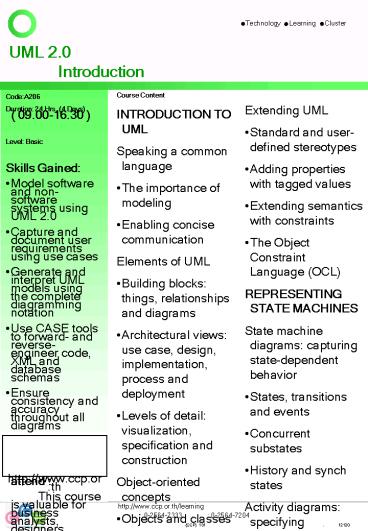UML 2'0 PowerPoint PPT Presentation
1 / 1
Title: UML 2'0
1
UML 2.0 Introduction
Extending UML Standard and user-defined
stereotypes Adding properties with tagged
values Extending semantics with constraints
The Object Constraint Language (OCL)
REPRESENTING STATE MACHINES State machine
diagrams capturing state-dependent
behavior States, transitions and events
Concurrent substates History and synch
states Activity diagrams specifying behavioral
logic Modeling workflows Partitioning
activities using swimlanes Concurrency and
synchronization of parallel activities
ARCHITECTURAL MODELING Packages and
interfaces Distinguishing between
classes/interfaces Exposing class and package
interfaces Subscribing to interfaces
Component and deployment diagrams Describing
dependencies Deploying components across
threads, processes and processors Design
patterns Patterns, mechanisms and frameworks
Representing design patterns APPLYING
UML Model-Driven Architecture (MDA) The
Meta-Object Facility (MOF) Common Warehouse
Meta-model (CWM) Life cycle stages Using UML
within the Unified Process Modeling business
processes Capturing requirements Systems
analysis Software design
Course Content INTRODUCTION TO UML Speaking a
common language The importance of modeling
Enabling concise communication Elements of
UML Building blocks things, relationships and
diagrams Architectural views use case,
design, implementation, process and deployment
Levels of detail visualization, specification
and construction Object-oriented
concepts Objects and classes Links and
relationships Inheritance and polymorphism
MODELING THE BEHAVIOR OF A SYSTEM Use case
diagrams describing user requirements Represent
ing systems boundaries Actors and use cases
Notations for refinement Sequence and
communication diagrams depicting typical event
scenarios Events and signals Showing
time-ordered behavior Expanding use cases into
the developers' view Converting between
sequence and communication diagrams Expressing
real-time aspects Synchronous/asynchronous
messages Representing timing constraints and
transmission delays Specifying
actions Describing action semantics Mapping
semantics to action languages Identifying
relationships between classes Dependencies
Associations Aggregation and composition
Generalization Object and class diagrams the
core of UML Showing classes and their
relationships Depicting snapshots using object
diagrams
CodeA206 Duration 24 Hrs. (4 Days)(
09.00-16.30 ) Level Basic Skills
Gained Model software and non-software systems
using UML 2.0 Capture and document user
requirements using use cases Generate and
interpret UML models using the complete
diagramming notation Use CASE tools to
forward- and reverse-engineer code, XML and
database schemas Ensure consistency and
accuracy throughout all diagrams Represent
design patterns in UML Who should attend
This course is valuable for business
analysts, designers, programmers, project
managers and all other personnel involved in
systems development. UML practitioners who wish
to update their skills to UML 2.0 will also
benefit. Knowledge of object-oriented techniques
is helpful but not required.
???????????????????????????????????????????????
??????????????????????????????????????????????
??? http//www.ccp.or.th

